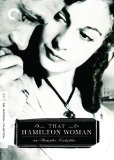| Reviews & Columns |
|
Reviews DVD TV on DVD Blu-ray 4K UHD International DVDs In Theaters Reviews by Studio Video Games Features Collector Series DVDs Easter Egg Database Interviews DVD Talk Radio Feature Articles Columns Anime Talk DVD Savant Horror DVDs The M.O.D. Squad Art House HD Talk Silent DVD
|
DVD Talk Forum |
|
|
| Resources |
|
DVD Price Search Customer Service #'s RCE Info Links |
|
Columns
|
|
|
That Hamilton Woman - Criterion Collection
THE MOVIE:
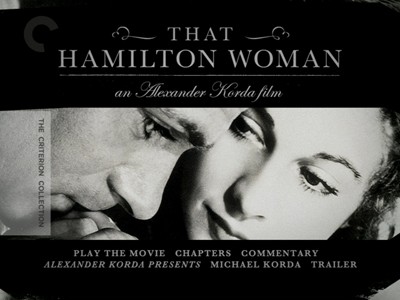
It's often said that real-life couples make fairly terrible onscreen lovers, that the removal of sexual tension between the performers takes any fire out of the performance. If they've already had each other, they don't look like they want each other anymore. Naturally, there are exceptions, with Humphrey Bogart and Lauren Bacall being the most obvious example from classic Hollywood. While their contemporaries Sir Laurence Olivier and Vivien Leigh don't nearly match those two in terms of chemistry, they do make for a fairly convincing couple in 1941's That Hamilton Woman, the second of two movies they made together. Both of those films were produced and directed by Alexander Korda, and That Hamilton Woman was tailor-made for this scandalous pair. What better for the film world's most notorious adulterous couple than a movie about one of history's most famous versions of the same?
Set at the close of the 18th century, That Hamilton Woman stars Olivier as Lord Horatio Nelson, the naval hero who pursued Napoleon's fleets around the world, staving off the French conqueror's expansion of his empire. Leigh is Lady Emma Hamilton, the wife of the British Ambassador to Naples, Sir William Hamilton (Alan Mowbray). Their marriage was one arrived at by less-than-conventional means. A commoner by birth, Emma entered high society via a gossip-ridden past, leaving dancehalls and brothels to be the kept woman of various men, including William Hamilton's nephew. This younger Hamilton ended up selling Uncle Will his art collection to pay off some rather heavy debts, and along with the statues and paintings, he included the subject of one of the traded portraits--Emma. Though at first incensed by this breech of trust, Emma relents and makes the best of the arrangement, becoming a regular face around the royal court in Naples.
The paths of Nelson and Emma cross when the seaman comes to Naples upon the outbreak of war with France in hopes of enlisting this allied country's Navy to aid England. Though William promises to move Nelson's request through slow bureaucratic channels, Emma surreptitiously uses her friendship with the Queen (Norma Drury) to get Nelson his ships at the speed with which they are required. Nelson is impressed by this seemingly frivolous woman's diplomatic powers. Behind her parties and her fancy dress lies Britain's real diplomatic influence, just as the Queen is the real influence behind her beleaguered King (Luis Alberni). For the next several years, even as constant warring takes an eye and an arm from him, Nelson continues to make Naples a port of call, fomenting the friendship between himself and Emma, and ultimately, succumbing to the fires of romance.
Given the year of production, there is a none-too-obvious double meaning in Nelson's campaign against Napoleon. The film had Winston Churchill's full support, and the terms with which Nelson speaks of the French madman and his will to power, as well as the pride and praise lavished on England, were meant to stir up patriotic pride in the moviegoing public. I suppose we could read even further into Walter Reisch and R.G. Sherriff's screenplay and discern that the portrayal of Emma's efforts on behalf of her country and its fighting men is meant to remind modern ladies how they can contribute to the battles on the home front. Of course, this also can require great sacrifice, and the biggest one in That Hamilton Woman comes about 2/3 into the film when the lovers agree to return to their spouses for the good of England. Every citizen must do the right thing for their country, even if it means never-ending unhappiness. As far as propaganda is concerned, it's actually handled more deftly than my description makes it sound. In fact, were you to never flip over the DVD box and consider the date at the top, you probably wouldn't even make the connection. I could have actually done with it being a little stronger myself. The only sea battle we get to see is the one at the climax of the picture, and it's magnificently staged. A little more blood and thunder of that variety couldn't have hurt.
Then again, That Hamilton Woman isn't about passions realized, but about denial and separation and the price of hidden love. War, gossip, prior commitments--these are the things that push lovers apart, but also the source of their determination to be together. This is where the reality of Olivier and Leigh's actual lives crosses over with their fictional cinematic lives, and how Korda, whether he knew he was doing it or not, skirted around the problem of an acting couple playing sweethearts onscreen. The two had been married the year before, having finally secured divorces from their former spouses, and they had suffered interference from American producer David O'Selznick, who continually aggravated their efforts to work together, and less-than-generous press coverage of their affairs, both private and professional. By the time Korda rolled his cameras, the duo had a pretty solid grasp of what Horatio Nelson and Lady Hamilton had experienced over a century prior. Once their love has been confessed, most of their scenes begin with distant smoldering and end in painful separation. The few embraces they share are impulsive explosions, made all the more eruptive by the denial that has held them apart. (And, in case we weren't fully aware of the danger, Korda helpfully places a smoky Vesuvius in the distance, viewable from Emma Hamilton's bedroom window.)
That Hamilton Woman first quite snugly with the other popular melodramas of the day, including many that Olivier and Leigh starred in. Korda's direction is straightforward and sincere, with the look of Wyler's Wuthering Heights and the underlying darkness of Hitchcock's Rebecca, both of which featured Laurence Olivier. The film's historical setting and its concerns with the role of women in wartime are also fittingly reminiscent of Vivien Leigh's most famous turn as Scarlett O'Hara in Gone With the Wind, even if the drama is far more contained this time around. Leigh's later career is largely comprised with roles of women who succumb to adultery, such as Anna Karenina and The Deep Blue Sea, and Emma's fate, as witnessed in the bookends on this picture, points the way toward the fate of Blanche Dubois in A Streetcar Named Desire. It's almost as if Hollywood branded the actress with a scarlet letter they would never let her remove.
Indeed, despite the backstage truth, Hollywood had quite a few limitations on how it could show such activity in front of the curtain, which is why the final act of That Hamilton Woman goes into such dark territory. Both cheaters had to be punished, it didn't matter whether the story was based in historical truth or not. Personally, I think the movie is better beforehand, what with all the stolen glances and whispers in the shadows, and this is why Nelson's last stand is so vital. Otherwise, the bleak nature of those last scenes would be too much. As it is, in terms of plotting, there is actually too little, with Emma's sad collapse happening too quickly. The very last lines of dialogue, delivered as we return back to the framing device, sound tacked on, as if to explain why the story stops short. And then there was no more, you say? Cue "The End."
Even so, I still quite like That Hamilton Woman. Olivier is fantastically conflicted, playing the egotistical Nelson like an unsure schoolboy whenever it comes time to make a decision about Emma, and Leigh also quite ably shows the dual nature inherent in her role. Emma's sprightly exterior is the product of much calculation. She's a woman used to finding a way to get her way. In the end, her problem is that the world has greater claims on the man she loves, and it's the world that gets to write the story.
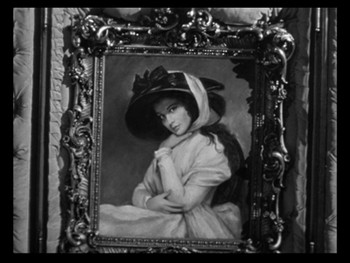
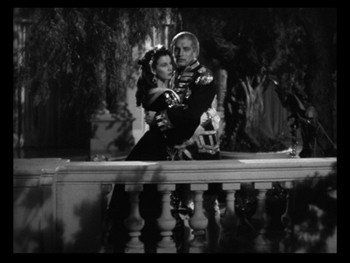
THE DVD
Video:
Criterion brings That Hamilton Woman to DVD at its original 1.33:1 full frame aspect ratio (pictureboxed). The restoration on the black-and-white image is very good, but not perfect. There are multiple instances of lines and scratches on the picture, which likely reflects problems with the source material that could not be properly fixed. Thankfully, outside of some background haziness from time to time, the majority of the movie is free of this damage and the overall look of the print is very good. The blacks are solid, and the balance between the dark and the light is excellent.
Sound:
The Dolby treatment on the monaural English-language soundtrack is fantastic, with clear tones and no extraneous sounds or distortion.
There are optional English subtitles for the deaf and hearing impaired.
Extras:
That Hamilton Woman - Criterion Collection is released as a single disc in a clear-plastic case with a double-sided cover. It comes with a 16-page booklet featuring photos, a chapter listing, cast and crew credits, and an essay by Molly Haskell, a film reviewer who has also written a book about Gone with the Wind, thus making her fairly knowledgeable on the subject of Vivien Leigh..
In terms of extras on the disc, Criterion leads with a new audio commentary by British film historian Ian Christie. Regular Criterion viewers will recognize Christie from the many other commentaries he's done, and he brings his usual lively scholastic style to the track here. He gives a comprehensive talk, addressing the origins of the film and why it may have been overlooked over the years. The true history of the figures portrayed is discussed, as well as the histories of the players involved. I quite liked his stories of the many admirers of the real Lady Hamilton and the ways Korda found to display her virtues and vices and stay out of trouble with the production code. Outside of that, Christie dissects the style and technique of the filmmaking.
Michael Korda, an author and the nephew of Alexander Korda, sits down in front of the camera for a 35-minute interview about his memories of That Hamilton Woman. He was a child on the set and played around in the boats while it was being made in California. He shares some background on the production, including its connection to the war effort, as well as on the personal lives of the participants before and after the movie. He also explains his impressions of the finished product. His father was also part of the production design team, and the whole movie was shot quickly and under extreme financial constraints, making for less-than-ideal conditions.
Alexander Korda Presents is a 14-and-a-half minute radio piece from 1941, promoting the film from the set, including detailed descriptions of the ships and other set pieces. Audio clips from the movie are also used. It's like the old school version of a DVD extra.
Finally, the original trailer for That Hamilton Woman is included.
FINAL THOUGHTS:
That Hamilton Woman is a lot of things: a historical romance, a propaganda picture, and a tragic drama chiefly among them. It's also one of only two cinematic pairings of real-life couple Laurence Olivier and Vivien Leigh, and the scandalous lovers they play, the heroic Lord Nelson and his passionate paramour Lady Emma Hamilton, provide perfect cinematic avatars for their controversial public personas. There is a lot of passion denied and plenty of punished sins in That Hamilton Woman, which makes up for its downbeat final act. A solid package, Highly Recommended.
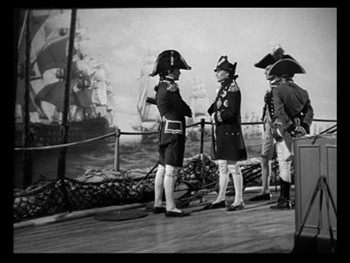
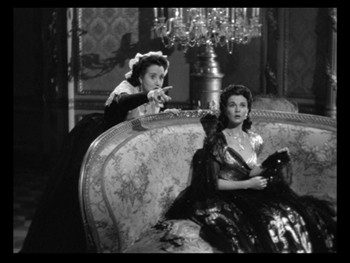
Jamie S. Rich is a novelist and comic book writer. He is best known for his collaborations with Joelle Jones, including the hardboiled crime comic book You Have Killed Me, the challenging romance 12 Reasons Why I Love Her, and the 2007 prose novel Have You Seen the Horizon Lately?, for which Jones did the cover. All three were published by Oni Press. His most recent projects include the futuristic romance A Boy and a Girl with Natalie Nourigat; Archer Coe and the Thousand Natural Shocks, a loopy crime tale drawn by Dan Christensen; and the horror miniseries Madame Frankenstein, a collaboration with Megan Levens. Follow Rich's blog at Confessions123.com.
|
| Popular Reviews |
| Sponsored Links |
|
|
| Sponsored Links |
|
|
| Release List | Reviews | Shop | Newsletter | Forum | DVD Giveaways | Blu-Ray | Advertise |
|
Copyright 2024 DVDTalk.com All Rights Reserved. Legal Info, Privacy Policy, Terms of Use,
Manage Preferences,
Your Privacy Choices | |||||||









